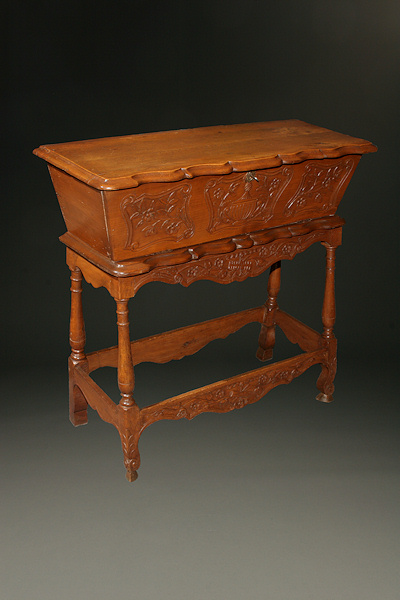One of our most intriguing antiques, panitierres evoke interesting guesses in answer to the question –“What is it?” Chicken coop; Bird cage; Baby crib; wild hypotheses are encouraged. Visitors ask more often about these pieces than any others in the shop. We feel they are an exquisite example of the marriage between style and function.
A panitier is a breadbox. In French, pain means bread and tier means cabinet. During the 17th, 18th and 19th century, the French used these pieces to store bread, letting the loaves breathe and air dry to the crispy crust that French bread is known for. We rarely find panitierres with the original fabric that lined the interior, which we feel was used to add decoration and to filter dust and dirt. The legs allowed them to be taken off their iron wall hooks and placed as a beautiful dining table centerpiece. These pieces represent the epitomy of French Country culture – bread-making.
Panitierres are always made out of wood and in a variety of species. Fruitwoods are the most popular – cherry, oak and walnut. The highly decorative style reflects its evolution from a common box on the wall through the styles of the 18th and 19th century. Circa 1890, the panitier pictured below is crafted from hand carved oak with hand-wrought iron escutcheon, turned spindles, and cabriolet legs. Decorative carvings adorn the piece, featuring flowers, an urn, and musical instruments, which indicate a love of the arts. The top is crested with nine hand-turned finials. This panitier is a fine example of how a family would represent their interests in the design of custom-made pieces.

After the use is established, the second question we hear is “Why is there a lock on it?” The touch latches we have today did not exist in the 18th and 19th century, so the lock served as a handle and a latch. Also, as food was made by hand in the home, it was highly valued and most likely locked to keep kids, pets and thieves out.
Today, many antique lovers use panitierres just as you see them displayed in our shop – hung on the wall as a decorative piece. Copper pots, other decorative cooking items, or beautiful ceramics will be displayed inside them. We often see them accompanied by a petrin, or dough cabinet, underneath.

Click here to view our lovely collection of panitierres. Or, feel free to stop by and see them in person. Send us an email or give us a call at 1-800-860-0109 to make an appointment.
